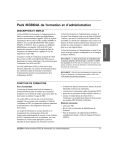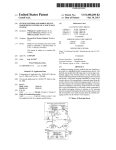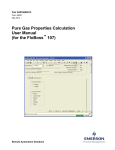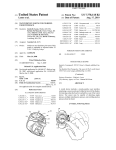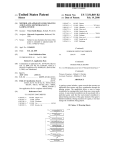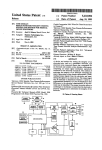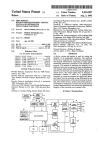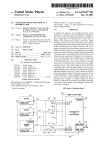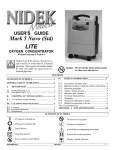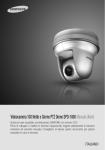Download Automatic external defibrillator with active status indicator
Transcript
US008498701B2 (12) United States Patent (10) Patent N0.: (45) Date of Patent: Vaisnys et a1. (54) AUTOMATIC EXTERNAL DEFIBRILLATOR WITH ACTIVE STATUS INDICATOR (56) US 8,498,701 B2 *Jul. 30, 2013 References Cited U.S. PATENT DOCUMENTS (75) Inventors: Gintaras A. Vaisnys, Chicago, IL (US); 4,101,787 4,590,943 4,610,254 4,619,265 5,224,870 5,285,792 5,350,317 5,372,605 5,470,343 5,483,165 5,579,234 5,591,213 5,640,078 Giovanni C. Meier, Madison, CT (U S); Glenn W. Laub, Princeton, NJ (US) (73) Assignee: De?btech, LLP, Chicago, IL (US) (*) Notice: Subject to any disclaimer, the term of this patent is extended or adjusted under 35 U.S.C. 154(b) by 87 days. This patent is subject to a terminal dis claimer. 2001178021 6/2001 OTHER PUBLICATIONS Prior Publication Data US 2011/0190838A1 Vail Paull et a1. Morgan et al. Morgan et al. Weaver et al. Sjoquist et a1. Weaver et al. Adams et a1. Fincke et a1. Cameron et a1. Wiley et a1. Morgan et al. Kou et a1. FOREIGN PATENT DOCUMENTS JP Apr. 14, 2011 (65) 7/1978 5/1986 9/1986 10/1986 7/1993 2/1994 9/1994 12/1994 11/1995 1/1996 11/1996 1/1997 6/1997 (Continued) (21) Appl. N0.: 13/086,436 (22) Filed: A A A A A A A A A A A A A Aug. 4, 2011 Heartstream®, Fore Runner® Semi-Automatic De?brillator User’s Guide, pp. 6-9 and 50. (Continued) Related US. Application Data (63) Continuation of application No. 10/ 678,593, ?led on Oct. 2, 2003, noW Pat. No. 7,930,023, Which is a continuation-in-part of application No. 10/453,312, ?led on Jun. 3, 2003, noW Pat. No. 7,495,413, Which is a continuation of application No. 09/960,859, ?led on Sep. 21, 2001, noW Pat. No. 6,577,102. (51) Int. Cl. A61N1/39 (52) (2006.01) US. Cl. USPC .................................. .. 607/5; 607/7; 607/148 (58) Field of Classi?cation Search USPC .................. .. 607/5, 142, 145, 148, 149, 29, 7 See application ?le for complete search history. Primary Examiner * Niketa Patel Assistant Examiner * Alyssa M Alter (74) Attorney, Agent, or Firm * King & Spalding LLP (57) ABSTRACT An AED includes de?brillation circuitry housed Within an enclosure, a ?rst processor programmed to periodically test the operability of the de?brillation circuitry and a second processor in communication With the ?rst processor. The AED further includes a visual indicator, such as a red/green LED, positioned at the exterior of the enclosure that is opera tively connected to the second processor. The second proces sor is programmed to control the visual indicator in response to the periodic test results provided to it by the ?rst processor. 7 Claims, 5 Drawing Sheets US 8,498,701 B2 Page 2 6,021,352 A 2/2000 Cllristopherson et al. 5 645 571 A US. PATENT DOCUMENTS 7/1997 Olson etal. g’gzg’g?g 2 25888 Evlley et 31' 5,697,955 A 5,700,281 A 12/1997 Stolte 12/1997 Brewer et al. 6’075’369 A 6’l85’458 Bl 60000 J; an 20001 ochgget a1 5,741,305 A 4/1998 5,773,961 A 5 749 902 A Vincent et al. 571998 01 1 ’ ’ ' 6,198,253 B1 3/2001 Kurle et al. M998 casrflgrgilaek 31 6,366,809 B1 4/2002 Olson et al. 5,797,969 5:792:190 A 8/1998 Olson et al. ..................... .. 607/5 2222223 Bl 6’577’l02 5% $5885 6/2003 V - 5 800 460 A 9/1998 Powers et al ’ ’ alsnys et a1 ' 5’8l7’l5l A “V1998 Olson et a1 ' 6,650,942 B2 11/2003 Howard et a1. 6,955,864 B1 10/2005 Valsnys et a1. 5’846’264 A 0/1998 Anderson ét a1‘ D405,754 S 5,868,790 A 5,868,794 A 2/ 1999 Barkley et a1. 2/1999 Vincent et al. 2/1999 Barkley et 31~ OTHER PUBLICATIONS Hewlett Packard, 43110 a De?brillator/Monitor Operating Guide, 2’333’333 2‘ 51333 i‘éil‘l‘lnefli‘l' Eighth Edition’ PP~ 2’ 5’ 36-39 Aug 19% 5,889,388 A 3/l999 Cameron et a1‘ Allgent Heartstream PR2, M3860A, M3861A, -User’s Guide, pgs. 5,889,925 5,891,049 5,897,576 D409,752 5,899,926 3/1999 4/1999 4/1999 5/1999 5/1999 Tsurutani et a1‘ Cyrus et a1. OlSOn et a1. Bishay et al. Ochs et 31' 2-1-2-2,204, 4-5, and B6 (assumed publlshed prior to ?llng date). Medtronic Physio-Control, Lifepack® 500 automated external de?brillator, Service Manual pp. 3 of 12-4-12, 7 of 12-10 of 12, 12 of 12, Medtronic Physio-Control, Lifepak® 500 Automated External 2 8108123162311 De?brillator Operating Instructions, pp. 2-5, 2-6, 5-7-5-11, 5-16-5 53944741 A 8/1999 Ochs et al. A A A s A 5,951,485 A 5,955,956 A 17’Mar12001: TM 9/l999 Cyrus et a1‘ Surv1val1nk FlrstSaVe 9/1999 Stendahl et al. 2931365170’ 84?“ 85, 2009 5,964,786 A 5,999,493 A 10/1999 Ochs et 31‘ 12/1999 Olson 6,016,059 A l/2000 Morgan . . Operatlon and Service Manual, pp. 20, Machine translation Of JP-2001178021. * cited by examiner . US. Patent Jul. 30, 2013 Sheet 1 of5 138 132 120 FIG. 1B US 8,498,701 B2 US. Patent Jul. 30, 2013 420 Sheet 2 of5 US 8,498,701 B2 US. Patent Jul. 30, 2013 Sheet 3 of5 US 8,498,701 B2 US. Patent Jul. 30, 2013 Sheet 5 of5 US 8,498,701 B2 US 8,498,701 B2 1 2 AUTOMATIC EXTERNAL DEFIBRILLATOR WITH ACTIVE STATUS INDICATOR result is that the de?brillation circuitry is operating normally; 2) cause the indicator to intermittently present the ?rst color When the de?brillator is off and the periodic test result is that the de?brillation circuitry is ready to operate normally; 3) RELATED APPLICATIONS cause the indicator to continuously present a second color, e.g., red, When the de?brillator is on and the periodic test result has detected an error in the de?brillation circuitry and 4) cause the indicator to intermittently present the second color When the de?brillator is off and the periodic test result has detected an error in the de?brillation circuitry. In another aspect, the invention is directed to an AED that provides visual and/or audible indications of the condition of This application is a continuation of US. patent applica tion Ser. No. 10/ 678,593, entitled “Automatic External De?brillator With Active Status Indicator,” ?led Oct. 2, 2003, now US. Pat. No. 7,930,023 Which is a continuation-in-part of US. patent application Ser. No. 10/453,312, ?led Jun. 3, 2003 (now US. Pat. No. 7,495,413), Which is a continuation ofU.S. patent application Ser. No. 09/960,859, ?led Sep. 21, 2001 (now US. Pat. No. 6,577,102). The complete disclosure of each of the above-identi?ed applications is hereby fully a de?brillator during use. These indications relate to the operation of the AED in conjunction With the electrode pad incorporated herein by reference. assembly used to monitor a patient’ s heart activity and admin ister de?brillation shocks. An AED related to this aspect of the invention includes de?brillation circuitry housed Within an enclosure and an BACKGROUND OF THE INVENTION 1. Field of the Invention This invention relates generally to external de?brillators, 20 (AED) having active status indicators that provide a continu ous indication related to the operational readiness of the de?brillator. The invention further relates to AEDs having other operation indicators that provide indications related to 25 the condition of the de?brillator during use. 30 are turned on. Other de?brillators perform self-tests on a periodic basis regardless of the on/ off state of the de?brillator. The results of these tests, hoWever, may not be indicated until subsequent turn-on of the AED or may not be readily apparent to the user of the AED. to monitor the operation of the de?brillation circuitry and electrode pad assembly and a visual indicator positioned at the exterior of the enclosure and operatively connected to the processor. The AED may also include a speaker. The proces sor is programmed to control the visual indicator and/or 2. Description of Related Art Conventional AEDs perform periodic self-tests to deter mine the operational readiness of the de?brillator. Some de?brillators perform such self-tests automatically When they electrode pad assembly adapted for electrical communication With the de?brillation circuitry at one end and a patient at the other end. The AED further includes a processor programmed and more speci?cally to automatic external de?brillators speaker in response to the results of the operation monitoring. These and other aspects and advantages of the invention Will become apparent from the folloWing detailed description and the accompanying draWings Which illustrate by Way of example the features of the invention. BRIEF DESCRIPTION OF THE DRAWINGS 35 Hence, those skilled in the art have recogniZed a need for FIG. 1A illustrates a top sectional vieW of an AED With a providing a continuous, active indication of the operational battery pack installed; readiness of an external de?brillator regardless of the on/ off state of the de?brillator. The need for additional indications of battery pack removed; the condition of a de?brillator during use has also been rec FIG. 1B illustrates a top sectional vieW of the AED With the 40 ogniZed. The invention ful?lls these needs and others. FIG. 2 illustrates a bottom vieW of the battery pack; FIG. 3 illustrates a side sectional vieW of the AED includ ing the battery pack; SUMMARY OF THE INVENTION FIG. 4 illustrates a side sectional vieW of the battery pack including ?rst and second battery units; Brie?y, and in general terms, the invention is directed to an AED that provides a continuous, active indication of the operational readiness of the de?brillator. This active indica tion is provided by a visual indicator carried by the enclosure of the AED. The visual indicator may be a single LED capable of displaying different ?rst and second colors, e.g., red and green. Alternatively the visual indicator may be tWo separate LEDs or may be a mechanical type indicator having different ?rst and second positions, each having an associated color. An AED incorporating aspects of the invention includes de?brillation circuitry housed Within an enclosure, a ?rst 45 FIG. 6 illustrates a block diagram of another con?guration of circuitry contained Within the battery pack and the AED; 50 DETAILED DESCRIPTION OF THE PREFERRED EMBODIMENTS 55 FIG. 1A illustrates a top sectional vieW of the Semi-Auto matic External De?brillator (“AED”) 100 that includes a the de?brillation circuitry and a second processor in commu nication With the ?rst processor. The AED further includes a e.g., green, When the de?brillator is on and the periodic test and FIG. 7 is a perspective vieW of anAED including an active status indicator. processor programmed to periodically test the operability of visual indicator, as described above, positioned at the exterior of the enclosure that is operatively connected to the second processor. The second processor is programmed to control the visual indicator in response to the periodic test results pro vided to it by the ?rst processor. Alternatively, the ?rst and second processors may be combined into a single processor. In one con?guration, the second processor is programmed to 1) cause the indicator to continuously present a ?rst color, FIG. 5 illustrates a block diagram of one con?guration of circuitry contained Within the battery pack and the AED; battery system, for example battery pack 110. The AED 100 60 is a device to treat cardiac arrest that is capable of recognizing the presence or absence of ventricular ?brillation or rapid ventricular tachycardia or other shockable cardiac arrhyth mias, and is capable of determining, Without intervention by an operator, Whether de?brillation should be performed. 65 Upon determining that de?brillation should be performed, the AED automatically charges and requests delivery of elec trical energy to electrodes that attach to a patient to deliver the energy to the patient’s heart. US 8,498,701 B2 4 3 The battery pack 110 provides power to components such need includes, for example, the poWer necessary to charge the capacitor 564 to delivery energy to the patient. The battery unit 410 is preferably not being drained of poWer When the AED is poWered off. as electronics and a charger located in the AED 100. The charger charges a capacitor 564 (FIG. 5) of the AED 100 that provides the electrical energy to the electrodes attached to the patient. TheAED 100 includes a generally rectangular shaped The battery unit 410 includes one or more battery cells, or battery Well 120 that is constructed and arranged to house the battery pack 110. The battery pack 110 is siZed to slide in and other poWer supplies, that are electrically connected together. The poWer supply may include other forms of energy storage, out of the battery Well 120 to releasably connect a poWer for example based on chemical or kinetic principles, such as supply of the battery pack 110 to the AED 100. a ?yWheel storage device. The battery cells can include, for example, 2/3 A siZe batteries and/or C siZe batteries. The number of batteries used varies depending on a particular application but typically includes ?ve or ten 2/3 A siZe batter FIG. 1B illustrates a top sectional vieW of the AED 100 and the battery Well 120 With the battery pack 110 removed. An entrance 210 of the battery Well 120 accommodates align ment of the battery pack 110 Within the battery Well 120. ies or four C siZe batteries. The ?ve 2/3 A siZe batteries or four C siZe batteries are connected in series. Also, tWo sets con FIG. 2 illustrates a bottom vieW of the battery pack 110. Referring to FIGS. 1B and 2, an opposite end of the battery nected in parallel of ?ve 2/3 A batteries connected in series can Well 120 includes a Wedge-shaped feature 230 that corre be used for the battery unit 410. The battery unit 410 prefer sponds to a Wedge-shaped receptacle 235 located in the bat tery pack 1 1 0. When inserting the removable battery pack 1 1 0 to the AED 100, the battery pack 110 is guided along by the battery Well 120 to the Wedge- shaped feature 23 0. The battery pack 110 is aligned at the end of its travel by the Wedge shaped feature 230 in the battery Well 120 via the corresponding ably poWers electronics and a charger located in the AED 100. The battery pack 110 also includes a secondary poWer supply, such as secondary battery 420. The secondary battery 20 Wedge shaped receptacle 235 in the battery pack 110. Referring to FIG. 1A, to maintain the battery pack 110 in a connected position relative to the AED 100, the battery pack 25 110 includes a latch 130 that retains the battery pack 110 Within the battery Well 120 When the battery pack is fully 420 poWers at least a portion of at least one of the AED and the battery pack 110 in an alternate mode, such as When at least a portion of theAED is poWered off. Those skilled in the art Will appreciate that the secondary battery 420 could also be used to poWer the AED during other modes, such as a sleep mode or When the AED is poWered on. The secondary battery 420 typically includes a single 9 Volt battery, but other poWer supplies could be used, such as other siZed batteries or other forms of energy storage. In a preferred embodiment, the inserted into the battery Well 120. An end of the latch 130 battery pack 110 accommodates replacement of the second connects With a spring 132 to bias the latch in a normally extended position. In the normally extended position, a latch 30 ing end 134 of the latch 130 extends to enter a corresponding slot 136 located in theAED 100. The latch 130 is moveable in a plane parallel to the spring 132 to compress the spring 132 to release the latching end 134 from the slot 136. When the latching end 134 is released from the slot 136, an ejection ary battery 420. The secondary battery 420 can be siZed smaller than the battery unit 41 0 and contain energy suf?cient to poWer, for example, electric circuitry of the AED 100 and the battery PCB 140. The secondary battery 420 can be used to poWer circuitry 35 exclusive of a state of the battery unit 410 and Without drain spring 137 located on theAED 100 pushes on the battery pack 110 to eject the battery pack 110 from the battery Well 120. The battery pack 110 includes a slot 138 from Which the latch 130 extends. Even in a fully contracted position, the latch 130 extends past the slot 138. The battery pack 110 also includes a printed circuit board (PCB) 140 including exposed electrical terminals 150 to con nect the printed circuit board 140 to electrical circuitry con tained in the AED 100, as described in more detail beloW. The PCB 140 includes electrical components that connect to cir ing poWer from the battery unit. Diodes 502 (FIG. 5) electri cally isolate the battery unit 410 from the secondary battery 420. Electric circuitry of the battery pack PCB 140 is 40 card (MMC). When the AED 100 is poWered on and attached to the 45 cuitry of the AED 100 When the battery pack 110 is installed in the AED 100. The battery pack 110 includes a WindoW 160 that is located proximate to a visual indicator, such as light emitting diode (LED) 550 (FIG. 5). The WindoW 160 alloWs an operator to vieW the LED 550 When the battery pack 110 is removed from the AED 1 00. Thus, the operator can determine a status of at least one of the AED 100 and the battery pack 50 55 WindoW 160 so that an operator can vieW the LED 550 When the battery pack is inserted in the AED 100. FIG. 3 illustrates a side sectional vieW of the AED 100 including the battery pack 110. The electrical terminals 150 of the PCB 140 contact a connector 310 located Within the 60 AED 100, to electrically connect the battery pack PCB 140 With an AED PCB 320. FIG. 4 illustrates a side sectional vieW of the battery pack 110. The battery pack 110 includes a ?rst poWer supply, such as battery unit 410. The battery unit 410 poWers essential poWer needs of the AED during a main operating mode, for example When the AED is poWered on. An essential poWer patient, the memory card 430 records the patient’s electro cardiogram (ECG) signals, audio signals received from a microphone located on the AED 100, and other operational information such as results of an analysis done on the patient by softWare of the AED 100. The memory card 430 may also hold ?les that may be used to upgrade the softWare of the AED 100 or to provide user training mode softWare for the AED. FIG. 5 shoWs a block diagram illustrating battery pack circuitry 500 contained With the battery pack 110, for example, on the battery pack PCB 140, and main unit cir 110 independent of the battery pack 110 being connected to the AED 100. It should be appreciated that theAED 100 could also include a WindoW located proximate to the battery pack described in more detail beloW With regard to FIG. 5. Such circuitry includes a socket to removably receive a memory device (FIG. 4), such as a memory card 430 or a multi-media cuitry 505. The circuitry 500 includes a main poWer sWitch 510. The main poWer sWitch 510 connects With a digital logic, such as micro-controller 520, that turns the main poWer sWitch 510 on and off and controls other circuitry 500 of the battery pack PCB 140. In addition to or in place of the micro controller 520, the digital logic can also include a micropro cessor, a programmable logic device (PLD), a gate array and a custom integrated circuit. Other digital logic could also be used such as a Programmable Interface Controller (PIC) manufactured by Microchip Technologies, located in Chan dler, AriZ. 65 The micro-controller 520 connects With a main AED con nector 53 0 that connects circuitry of the battery pack PCB 140 to circuitry of the AED 100. When the operator engages a US 8,498,701 B2 5 6 power switch 592 located on the AED 100, the micro-con troller 520 receives a signal from the main unit connector 530 regarding a status of components of the battery pack 110 and indicating that the power sWitch has been engaged. Thereaf that connects to a real time clock (RTC) 590, the EEPROM 580 and the micro-controller 520. Typically once per poWer the AED 100. The DSP 562 ofthe AED 100 connects to a bus ter, the micro-controller 520 enables the main poWer sWitch 510 to provide an electrical poWer betWeen the battery unit 410 of battery pack 110 and the electronics of the AED 100. The battery pack PCB 140 also includes a main battery con nector 540 to connect the battery unit 410 to the main unit up of the AED 100, the DSP accesses the RTC 590 to set a main unit clock of the AED 100 that is located in the DSP. The main unit circuitry 505 also includes a sWitch 592, such as an ON/OFF sWitch, that connects to the micro-con connector 530 and other circuitry of the battery pack PCB troller 520 via the main unit connector 530. A shock sWitch 140. The micro-controller 520 also controls a visual indicator, such as LED 550 and an audio indicator, such as sounder 560 that are used to automatically communicate information to 594 connects to the DSP 562 to alloW an operator to admin ister a shock to the patient. A speaker 596 and indicator LEDs 598 connect to the DSP 562 to supply instructions or other information to the operator. Front end circuitry 599 connects betWeen the DSP 562 and the patient interface 566 to process and/or provide the DSP 562 With information from the the operator. For example, When the AED 100 fails a self-test, the operator is noti?ed by a chirping sound from the sounder patient. 560. Moreover, the LED 550 blinks green to indicate that a status of components of the AED 100 is Within an acceptable operating range. Those skilled in the art can appreciate the opposite could be true, i.e., that a blinking light indicates a fault condition. According to a preferred embodiment, if the LED 550 is not blinking an error exists, for example, in the 20 (DSP) 18, Which is the main processor for the AED, andAED circuitry 20, Which consists of the remainder of the AED circuitry. For a description of additional AED circuitry circuitry 500, or the battery unit 410 or secondary battery 420 are depleted. The micro-controller 520 monitors a signal of a including the high-voltage circuitry used to generate and comparator connected to secondary battery 420 to monitor a status of the secondary battery 420, for example, to determine 25 deliver de?brillation shock, see U.S. Pat. Nos. 5,607,454 and 5,645,571, the disclosures of Which are hereby incorporated by reference. Alternate circuitry, Within the purvieW of one of ordinary skill in the art, may be developed and employed. Whether or not poWer of the secondary battery 420 is loW or depleted. Regarding the main unit circuitry 505, a digital signal Thus, the scope of this invention is not intended to be limited processor (DSP) 562 processes instructions and data of the AED 100. The DSP 562 connects With a charger circuit 563 With reference to FIG. 6, in another con?guration, the AED 10 consists of a main AED 12 and a removable battery pack 14. The main AED 12 includes a PIC processor 16, Which is used to control poWer to the AED, a digital signal processor 30 and discharger circuit 565 to control the charging and dis charging of main unit capacitor 564. The capacitor charger to the circuitry described in the incorporated references. The battery pack 14 is similar to that previously described With reference to FIG. 5, except that some components, 563 connects the battery unit 410 to the capacitor 564. The including the micro-controller 520 (FIG. 5), i.e., the PIC capacitor 564 connects to a discharge circuit 565 that con nects to patient interface 566 to deliver shocks to the patient. The micro-controller 520 also controls an active status indicator (ASI), Which in one embodiment is a red and green LED 567 located on the AED 100. In an alternate embodi ment the ASI may include tWo separate LEDs, a red LED and a green LED. The micro-controller 520 connects to the red processor, have been moved to the mainAED 12 (FIG. 6). The 35 battery pack 14 includes a battery 22, Which contains multiple battery cells, a real-time clock 24, Which keeps time and can generate an output signal on a regular basis, a poWer sWitch 26, Which is used to couple the battery 22 to the mainAED 12, 40 and green LED 567, for example, via pins of the main unit and a 9V battery 20 used to provide poWer to the PIC proces sor 16 during the times that the poWer sWitch 26 is off. The DSP 18 is con?gured to run a number of self-tests that connector 530. The micro-controller 520 causes the LED 567 check the operation of the DSP 18 and the AED circuitry 20 to blink green When the AED 100 is operating properly and on a periodic basis to ensure that the AED is fully operational. causes the LED 567 to blink red When components of the AED are not Within the acceptable operating range, for example, a component of the AED 100 failed during a self test procedure. If the LED 567 is not blinking When the battery pack 110 is installed into theAED 100, components of the AED 100 and the battery pack 110 should be checked. The operation of the AED self-test procedures and the ASI are described further beloW. The battery pack LED 550 is pref 45 nently poWered from the battery 22, issues a periodic signal, typically every ?ve seconds. This signal is routed to the PIC 16 and causes the PIC to “Wake up” from standby mode. At 50 erably disabled When the battery pack 110 is installed. The secondary battery 420 poWers the micro-controller 520, the LED 550 and the LED 567, Which helps to maintain the integrity of the battery unit 410 that provides poWer to electronics and the capacitor charger located in the AED 100. A secondary battery connector 570 connects the secondary battery 420 to the circuitry of the battery pack PCB 140. The battery pack circuitry 500 also includes an electrically erasable programmable read only memory (EEPROM) 580 that time, the PIC 16 ?ashes an ASI 30 to indicate AED status and also decrements a count of the number of times that it has been Woken up since the count Was last set. When this count reaches Zero, indicating that approximately 24 hours have 55 60 connected to the micro-controller 520 and the main unit con nector 530. The EEPROM 580 stores information that may be relevant to an oWner, service person or operator of the AED 100. The EEPROM 580 stores information regarding, for example, the number of shocks the battery unit 410 has been used for, that the AED 100 has been activated, the date of manufacture of the battery pack 110 and status information When the main AED 12 is poWered off, the PIC 16 is placed in a standby mode. The real-time clock 24, Which is perma 65 elapsed since the count Was last set, the PIC 16 turns the poWer sWitch 26 on Which applies poWer to the AED causing the DSP 18 to execute startup code. During the startup sequence, the DSP 18 communicates With the PIC 16 to determine the reason for the poWer-up. Typical reasons are that the user pressed the on/off button on the AED or that the PIC 16 has initiated a self-test. If the reason is a self-test, the DSP 18 executes self-test code Which tests a portion or a majority of the AED circuitry 20. The results of the self-test are communicated to the PIC 16 Which then displays the AED status by blinking the ASI 30. The PIC may also be con?gured to sound a sounder, e.g., speaker 32. When the test is complete, the DSP 18 sets the Wake-up counter to a value Which Will cause the PIC 16 to Wake up the DSP 18 approximately 24 hours later and initiates main AED US 8,498,701 B2 8 7 “Replace battery pack”iindicates that the battery pack is 12 shut-down. The PIC 16 then turns off power to the main AED 12 by switching off the power switch 26. In this manner the AED is tested on a regular basis. almost discharged and that the AED may not be able to deliver de?brillation shocks. The battery pack should be immediately replaced. Atypical testing schedule is to do the following self-tests at “Replace 9V battery”iindicates that the 9V battery in the battery pack needs to be replaced. The unit may not provide active status indication during standby mode in this condi the intervals indicated: Every day: basic circuitry tests. Once a week: basic circuitry tests, basic battery tests and tion, but the AED is still fully functional when turned on and may be used to treat patients. The 9V battery should be basic high voltage circuit tests, Once a month: basic circuitry tests, additional battery tests replaced as soon as possible. and comprehensive high voltage circuit tests, including As previously indicated with reference to FIG. 5, a speaker a partial-voltage internal shock. Once every three months: basic circuitry tests, additional 596 and indicator LEDs 598 are connected to the DSP 562 to supply instructions or other information to the operator. With further reference to FIG. 7, in one con?guration of the AED, these indicators 36 are located on the front panel of the enclo battery tests and comprehensive high voltage circuit tests, including a full-voltage internal shock. Tests are performed in a “silent mode” where no user interface elements are exercised and the user is not able to tell sure 34 and include a red “check pads” LED, a red “do not that the tests are being executed. The user may also indepen dently initiate a self-test by holding down the on/ off button 42 (FIG. 7) on the AED for ?ve seconds while turning the unit on. 20 This will cause an extended self-test, similar in scope to the “once every three months” test, to execute. With reference to FIG. 7, the ASI 30 is located on the upper right side of the AED enclosure 34. The status indications provided by the ASI are as follows: Steady-on green: the AED is on and operating normally. when to enable an LED 36 based on system state, i.e., con necting, motion, analyzing. The LED 36 can blink under software control by enabling and disabling the control line 38 25 Blinking green: the AED is off (in the stand-by mode) and is ready to operate normally. Steady-On red: the AED is on and has detected an error. Blinking red: the AED is off (in the stand-by mode) and the AED or battery pack needs servicing. Off: battery pack not installed, AED defective, or the 9V 30 Regarding the “blinking red” status, anytime the ASI 30 once again ?ash a status indication. If the 9V battery 28 is depleted, the AED will still be fully functional and can be used in the on-state normally. When the ASI 30 is blinking red, additional indications of the reasons for the blinking may be obtained by turning the AED on through the on/off button 42. These additional indi 35 over the speaker 32 in association with certain conditions. Voice prompts associated with the “check pads” LED include 40 mination may be made by measuring the impedance across the pads. A high impedance is an indication that the pads are 45 50 electrode pad assembly and the internal de?brillator circuitry. “Check pads” indicates that the pads are making improper contact with the patient and that the impedance is out of range, i.e., either too high or too low, for proper ECG analysis and shock delivery. 55 Voice prompts associated with the “do not touch patient” LED include “do not touch patient”, “stop motion” and “stop interference”. “Do not touch patient” indicates that the DSP 18 is in the process of analyzing the patient’s heart rhythm 60 servicing. The code number xxx indicates the type of problem that the unit is experiencing. and that the operator should not touch the patient. The DSP 18 is programmed to analyze ECG signals once it has deter mined that the electrode pads are making good connection to the patient. The “do not touch patient” message is spoken at the beginning of the ECG analysis period and also if motion or interference has been detected. “Stop motion” indicates that the DSP 18 has detected motion in the patient, such as “Battery pack low”iindicates that the battery pack capac the ?rst time this message is spoken. either not connected to the unit or not placed on the patient while a low impedance serves as an indication that the pads may be shorted together. What is considered “high” or “low” impedance is dependent on the electrical characteristics of has detected an internal error, is non-operational and needs able to deliver at least a minimum of six de?brillation shocks “connect pads” and “check pads”. “Connect pads” indicates that the DSP 18 has determined that the pads are not properly connected to the unit or not placed on the patient. This deter AED has failed the power-on self-test and is non-operational and needs servicing. The code number xxx indicates the type ity is low and should be replaced soon. The AED will still be provided by voice prompts. In addition to the indications provided by the blinking LEDs 36, the DSP 18 is programmed to output voice prompts “Power on self-test failed, error ‘xxx’”iindicates that the of problem that the unit is experiencing. “Battery pack self-test failed, error ‘xxx’”iindicates that the AED’s battery pack is non-operational and needs servic ing. The code number xxx indicates the type of problem that the unit is experiencing. “Error ‘xxx’, service required”iindicates that the AED ditions. The “check pads” LED blinks when the DSP 18 detects that the patient electrodes are not properly applied. The “do not touch patient” LED blinks when the DSP 18 detects patient motion and at times when the operator should stay clear of the patient. The “analyzing” LED blinks when cess of determining conditions that activate these LEDs is described below within the context of additional indications cations are provided by voice prompts programmed into the DSP 18 and output over the speaker 32. These voice prompts include: at timed intervals. The DSP 18 enables an LED 36 under the following con the DSP 18 is analyzing the patient’s ECG Signal. The pro battery is discharged. blinks red, the PIC 16 causes the speaker 32 to beep periodi cally to call attention to the AED. The ASI 30 is powered by the replaceable 9V battery 28 in the battery pack 14. If the 9V battery 28 has discharged, active status indication will not be available. In this case, the 9V battery 28 should be replaced. Once the 9V battery 28 has been replaced, the ASI 30 will touch patient” LED and a green “analyzing” LED. As shown in FIG. 6, the indicator LEDs 36 are directly controlled by the DSP 18. Each LED 36 has a separate control line 38 and driver circuit 40. When the control line 38 is active the LED 36 is powered and lights up. The DSP 18 determines 65 may occur during the administering of CPR. “Stop interfer ence” indicates that the DSP 18 has detected interference on the ECG signal. In each of these cases, the DSP 18 monitors US 8,498,701 B2 9 10 the characteristics of the ECG signals for indications of patient motion, e.g., an unexpected spike in the signal, and signal interference, e.g., a signal pattern containing noise or a signal of Weak amplitude. Voice prompts associated With the “analyzing” LED 5 include “analyzing heart rhythm” and “analyzing inter rupted”. “Analyzing heart rhythm” indicates that the DSP 18 is actively analyzing the patient’s ECG signal. The DSP 18 2. The external de?brillator of claim 1, Wherein the self-test is autonomous and recurring. 3. The external de?brillator of claim 2, Wherein the self-test is selected from a group of self-tests of varying degrees. 4. The external de?brillator of claim 1, Wherein the illumi nated ?rst light source blinks frequently. Will continue analyzing until it has determined Whether a rhythm is shockable or non-shockable or analyzing is inter rupted for some reason. “Analyzing interrupted” indicates that the DSP 18 has determined that accurate ECG analysis is not possible and has ceased analyzing. The DSP 18 deter mines this condition by monitoring the ECG signal as previ ously described With respect to patient motion, signal inter ference and check pads. While the other LEDs may blink during this process, the “analyzing” LED Will not be lit during this message. While the invention has been described above by reference to various embodiments, it Will be understood that many changes and modi?cations can be made Without departing from the scope of the invention. It is therefore intended that the foregoing detailed description be understood as an illus tration of the presently preferred embodiments of the inven tion, and not as a de?nition of the invention. It is only the 5. An external de?brillator, comprising: a battery; de?brillation circuitry, the de?brillation circuitry poWered by the battery and including a micro-controller programmed to conduct a self-test 20 25 and programmed to perform a rescue by executing a program stored thereon, the self-test including at least some portion of the de?brillation circuitry, the self test capable of determining an operational status of the external de?brillator; an active status indicator comprising a ?rst light source that illuminates, the ?rst light source operated by the programming running on the micro-controller and folloWing claims, including all equivalents, Which are intended to de?ne the scope of this invention. What is claimed is: mounted on a surface of the external de?brillator, the surface visible from an exterior of the external 1. An external de?brillator, comprising: a battery; Wherein When the most recent self-test has deter mined that the de?brillator operational status is nor mal, the ?rst light source illuminates to indicate that the de?brillator is ready for use Wherein the self-test is conducted With the de?brillator being OFF from the perspective of a user. 30 de?brillation circuitry, the de?brillation circuitry poWered de?brillator, Wherein When the self-test has deter mined that the de?brillator requires maintenance, the by the battery and including ?rst light source illuminates to indicate that the a micro-controller programmed to conduct a self-test de?brillator requires maintenance; and and programmed to perform a rescue by executing a program stored thereon, the self-test including at least some portion of the de?brillation circuitry, the self test being capable of determining an operational sta tus of the external de?brillator; and 35 an active status indicator comprising a ?rst light source that illuminates, the ?rst light source operated by the programming running on the micro-controller, 40 Wherein the self-test is conducted With the de?brillator being OFF from the perspective of a user. 6. The external de?brillator of claim 5, Wherein the self-test is selected from a group of self-tests of varying degrees. 7. The external de?brillator of claim 5, Wherein the illumi nation is blinking frequently. * * * * *












